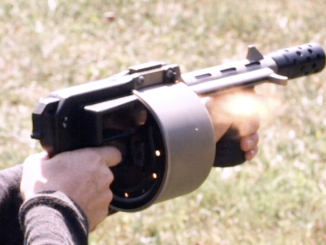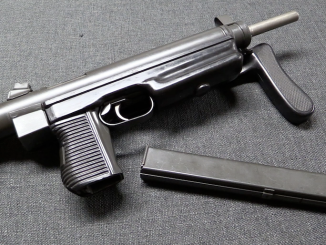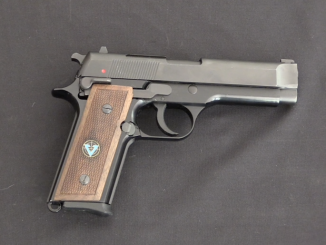In the 1980s, the South African military and police were using substantial numbers of different handguns, and began looking for a way to consolidate to simply maintenance and logistics. Studying the different guns they had, they decided to pursue a copy of the Beretta Model 92. No foreign manufacturer was willing to undertake production for them because of the international sanctions then in force against South Africa, so instead Musgrave and Lyttelton Engineering opted to reverse engineer the gun and produce them domestically. A batch of 20 Berettas were used in a remarkable program which successfully recreated a full technical data package for the pistol, and production was begun by Vektor under the designation Z88. Aside from changes to markings and grip panels, the Z88 was a faithful and parts-interchangeable copy of the M92.
Beretta was not happy about this, of course, but attempts to bring a lawsuit against Vektor were equally stalled by the sanctions, which prevented South Africans form traveling internationally. Eventually, a settlement was negotiated to allow Vektor to produce the Z88 for use within South Africa (but not for export). Shortly thereafter the sanctions were lifted, and Vektor decided to modify the gun enough to give it a new name and offer it for export (and domestic) sale.
This new pistol was the SP1, and it changed the profile of the Beretta, replaced the distinctive open slide with a fully enclosed (and simpler to machine) slide, and replaced the slide mounted decker with a frame mounted manual safety. These were produced and marketed in several variations (compact, service, target, and competition) in 9mm and also as the SP2 in .40 S&W. Production of both ceased in 1998, when Vektor shut down all small arms production.




Ian, hope you are considering doing a piece on the Vektor CP1 also. Unique approach to safety operation and also polymer frame when this was still relatively new in RSA.
It is interesting that Vektor seems to have taken a bunch of design/style cues from the Llama Omni line, with these pistols. One wonders where that came from.
“decker”
What is decker? I never meet that term earlier.
Autoincorrect strikes again
?decocker
Its all good just as long it is not DRECKer :-))
another surprisingly well made gun from a country not really known for well made firearms.
you pretty much hit on what is wrong with the world: no one cares about making a better experience, only their own recognition.
Do the SP-1s take Beretta mags?
“Studying the different guns they had, they decided to pursue a copy of the Beretta Model 92”
What other automatic pistol they were examining? Why they choose that particular one.
“Z88. Aside from changes to markings and grip panels, the Z88 was a faithful and parts-interchangeable copy of the M92.”
This is outstanding feat. Do anybody know if there was any difference between steel used in original and Z88?
Finally, I must remind that Imitation is the sincerest form of flattery.
“Do anybody know if there was any difference between steel used in original and Z88?”
That’s something I was wondering, my guess is that it was chemically close to the exact formulation used, the main issue would be if there is nickel added in slightly different amounts, or were they able to use say, mass spectrum analysis back then, or something similar to some metal shavings.
Back in the days of the National Party rule (I’m not going to say “apartheid” apartheid is still there, only reversed, in the strange beliefeeling that two wrongs can somehow make a right)…
S’frica was the major source of chromium, vanadium, nickel and manganese outside of the iron curtain, as well as diamonds and precious metals, I can’t remember about tungsten or molybdenum.
It was one of the scaremongering stories at those later stages of the cold war, that an ANC regime could cut off the supply of strategic metals
Leaving all the major supplies under the control of communist regimes
Both national party ruled south Africa and even it’s ltitle sibling to the north, UDI Rhodesia under Ian Smith
Were able to reduce the bulk and add value to their exports, by producing stainless steels.
If you were going to go for national autarky of production, whether through choice or through sanctions, s’frica and Rhodesia were pretty well positioned to achieve it
South Africa had technology to make nuclear weapons by the late 70-80s, for chrissakes,
Rhodesia in comparison to that was almost third world country.
But I agree on the idea, of instead crappy lot of independent small designs, they should have all get together and copy an existing foreign design (and leave Ian with dozen of designs less to investigate, so that would be bad)
But that is not easy and often “the government” (sometimes just basicly a gang of criminals hiding under that noble name)
is not willing to sponsor anything, especially if you have corrupt officials that siphon the money from the pricey purchases on the international black market (as Rhodesia was under arms embargo) thus domestic production being competition to their schemes.
I’m almost sure good old Ian (Smith hehe) always suggested throwing some get together partys for the domestic designers, but when they demanded some funds, at least for the booze and snacks (not to mention machines and raw materials), subject of talk was promptly dropped and changed.
Even under apartheid, South Africans were quite free to travel to other countries, so I do not think that had anything to do with Beretta’s failure to enforce its case in this matter.
I think it is more likely that, given the arms embargo, the South African government would have refused to allow a case against Vektor to proceed in South Africa, and thus Beretta would have had no way of obtaining redress. They could have sued Vektor in Italian courts, but it would have been a waste of time, as they would have had no way to enforce their judgment. So long as Vektor only operated within South Africa, there would have been nothing Beretta could have done. But if Vektor wanted to sell into other countries, then they would have to reach an agreement with Beretta, which happened in the end.
It’s interesting to see that the SP1 went with a full-coverage slide, much as FN did with the BDA 380, their version of the Beretta Model 84BB in .380.
I wonder if this was their way of avoiding the slide failures U.S. M9 Berettas experienced early on with hot “9mm carbine”-type ammunition.
cheers
eon
Would like to see vid.on round slide Musgrave pistol !
@Storm wrote But that is not easy and often “the government” (sometimes just basicly a gang of criminals hiding under that noble name)
The “sometimes” is noted,
You are a very generous and optimistic gentleman 🙂
A few weeks ago, there was a funeral, and there was a reading that the deceased gentleman had asked be read out
He had searched high and low, left and right for many decades, he left no stone unturned (his patch was particularly stony) in his search for a straight banana.
In his later years, after much tireless searching, he had arrived at the unfortunate conclusion, that perhaps there is no such thing as a straight banana.
He also searched high and low, left and right and left no stone unturned in his search for a straight
land agentpolitician.Unfortunately he also arrived at the conclusion that they don’t exist either.
Many thanks for the info on Vektor
I hadn’t realised that they were state sector, Or semi state.
National Party S’ifrica was like too many other places; “everything within the state, none outside it, none against it”*
Is there a vid coming on the ill fated little Vektor 9mm gas buffered jelly bean styled pistol?
____________________
*Benito Mussolini, paraphrasing the German Idealist philosophers